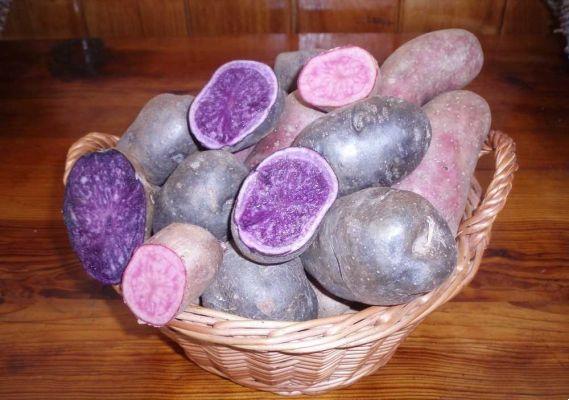
Potatoes are a well-known tuber and highly valued for their flavor. We usually know potatoes with a white or yellow internal pulp and a brownish-gray skin. Instead there are many varieties of potatoes with different colors of both flesh and skin. Let's get to know purple potatoes, blue potatoes and red potatoes.
The purple and blue potatoes
Potatoes with dark skin and purple or blue color of the pulp are usually more floury than the classics yellow or white potatoes.
Let's get to know some purple and blue potato varieties:
> Purple "velvet Queen" potatoes: This potato is a variety with blue flesh and purple skin. The shape of the tubers is the same as ordinary potatoes. The particularity is hidden not only in the blue and purple color but also in the flavor reminiscent of hazelnut. The use is equivalent to the classic potatoes.
> Patata "Blu star": The pulp of this potato is blue in color while its skin is gray. The Blue star potato is a variety that it was only recently introduced and is very similar to classic white and yellow pulp potatoes. The use is therefore identical for preparations in the kitchen.
> The vitelotte potato: This potato comes from from the lands of Peru and Chile and it is quite difficult to find it in the country. It is currently also cultivated in France and it is one of the oldest potatoes obtained by natural selection and not genetically modified. It is also known by the name of black potato or purple potato and differs quite a lot from the classic potatoes.
The consistency of the pulp is firm, sticky and after cooking it is floury, while the flavor is reminiscent of chestnuts. The peel is thick, hard and its color is very dark between black and purple gray. The shape is elongated and wrinkled quite lumpy with dimensions smaller than the common potatoes. It is harvested in late summer.
The use in the kitchen remains the typical one of potatoes so be it for preparations in puree, boiled, fried, baked or as an ingredient for other traditional recipes such as gnocchi. A peculiarity of this vitelotte potato is that of changing the color of the pulp once cooked in fact it becomes from purple to blue and its cooking water instead is green.
Read also Potatoes from the world >>
The properties of purple and blue potatoes
These potatoes have slightly different properties from the classic yellow or white pulp potatoes obviously because the natural pigments that give it its color are also nutritional elements of high biological value.
In fact the purple and blue potatoes are rich in anthocyanins, water-soluble substances that are part of the flavonoid family. Their main activity is to be gods strong antioxidants therefore capable of fight free radicals and help prevent cellular aging.
They are very effective anti-aging and also protect the body from many degenerative diseases thanks to their ability to reduce DNA damage.
To all intents and purposes they are anti-cancer molecules that even help stimulate the production of the cytokines necessary for a good activity of the immune system.
Read also 3 recipes with purple potatoes >>
The red potatoes
Finally there are the potatoes a red skin with light pulp usually yellow. In general they taste great and some are very sweet even suitable for the preparation of desserts such as pancakes. The consistency is slightly floury.
Originally red-skinned potatoes are traditional of the lands of Northern Europe where they are cooked while also keeping the peel. This is because there are numerous active ingredients on the peel and nutritional substances such as vitamins, mineral salts and natural pigments which are beneficial for the health of our body.
Also like all potatoes they are rich in potassium essential for regulating blood pressure and vitamin A and C as well as many antioxidant flavonoids. Finally, potatoes even regulate blood sugar levels by helping insulin balance.
Red Cetica
This potato is one variety grown in Tuscany in the area of Cetica from which it obviously takes its name. His flavor is slightly salty and is therefore much tastier than all the classic potatoes. This local potato variety is recognized as particularly valuable and sought-after potato even by the most renowned chefs.
Read also How to cook tubers and roots >>


























